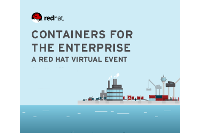The Friday Five is a weekly Red Hat® blog post with 5 of the week's top news items and ideas from or about
Red Hat and the technology industry. Consider it your weekly digest of things that caught our eye.


CHECK IT OUT:
Registration for 2017 Red Hat Summit is open
Registration is now open for the 2017 Red Hat Summit! Learn, network, and experience open source at every level with hundreds of sessions led by the best and brightest in open source, hands-on experience with our newest technologies, face-to-face interaction with product experts–or the actual builders–demonstrating the latest technologies, the chance to grow your network, reconnect with peers, and make new partnerships. The event will be in Boston at the Boston Convention and Exhibition Center, May 2-4, 2017. Early bird registration ends March 2.


CHECK IT OUT:
Containers for the Enterprise - A Red Hat virtual event
Now more than ever, we know that modern application development and deployment are tied to business growth. A business is 8 times more likely to gain share if it is at the forefront of digital maturity. Speed, security, and operational efficiency are key elements that will determine success or failure. Linux® containers, used correctly, will help your organization deliver all three. Sign up and attend Containers for the Enterprise | A Red Hat virtual event to find out how to unlock the potential of Linux containers in their enterprise. The live event will take place Thursday, January 19, 2017 at 11 a.m. ET | 4 p.m. UTC.


IN THE NEWS:
CRN - The 10 Coolest Open Source Products Of 2016
In 2016, open source products were front-and-center. A number of new offerings in containers, networking, storage and other major areas were among those that debuted during the year. At #4 is Red Hat Ceph Storage 2. Red Hat this year unveiled a major update to Ceph Storage, the company's open software-defined storage platform — the first new version of the platform since Red Hat acquired the technology in 2014. Ceph Storage 2 introduces a new storage management system and new features geared toward object storage workloads, such as new global object storage clusters that offer better data synchronization between distributed clusters and other benefits.


GOOD READ:
Red Hat Enterprise Linux blog - Five Reasons to Switch from vSphere to Red Hat Virtualization
It's time to upgrade or to renew your VMware vSphere licenses. This decision is not easy for a few reasons such as: One or more of your VMware products are end of life, or there are hundreds or thousands of virtual machines (VMs) in your environment and the costs to maintain them has significantly gone up. I have good news for you. There is a reliable and enterprise choice and switching has never been easier with the recent release of Red Hat Virtualization 4. You can run Red Hat Virtualization alongside VMware and migrate workloads in phases, perhaps starting with dev/test. Compared to competing products, Red Hat Virtualization delivers easier integration and interoperability with existing infrastructure, higher density and performance, and improved economics. Read more on the 5 reasons you should switch to Red Hat Virtualization.


RECOMMENDED READING:
The FOSS Post - Insights on Red Hat, SUSE & Canonical; The Major Linux Companies
Today, the Linux operating system is used almost everywhere, from web servers, android devices, supercomputers and to IoT devices. Linux has become more than just an operating system, and because of this, it has created huge opportunities for enterprises to benefit from. This market allowed great tech companies to be established to fulfill its needs, which gave us the 3 major Linux companies: Red Hat, SUSE and Canonical. The business model for each of the major companies was similar: selling support services and subscriptions for their own open source and Linux-based products. Since its establishment in 1993, Red Hat grown to become the biggest Linux and open source company and a key player in the open source world. Red Hat offers a lot of solutions and services, however, Red Hat also provides a lot more than products and technologies. Red Hat certifications are one of the most valuable certifications in the Linux market. If you are planning to get a career in this field, you definitely should look into the RHCSA (Red Hat Certified System Administrator) or RHCE (Red Hat Certified Engineer) courses. According to Red Hat, more than 90% of the top 500 fortune global companies rely on them for their infrastructure. The company is expecting a total revenue of around $2.4 billion for the fiscal year 2017 (which will end in February, 2017). Thus, making it–fairly–the largest open source company in the world.
저자 소개
Red Hat is the world’s leading provider of enterprise open source solutions, using a community-powered approach to deliver high-performing Linux, cloud, container, and Kubernetes technologies.
채널별 검색
오토메이션
기술, 팀, 환경을 포괄하는 자동화 플랫폼에 대한 최신 정보
인공지능
고객이 어디서나 AI 워크로드를 실행할 수 있도록 지원하는 플랫폼 업데이트
클라우드 서비스
관리형 클라우드 서비스 포트폴리오에 대해 더 보기
보안
환경과 기술 전반에 걸쳐 리스크를 감소하는 방법에 대한 최신 정보
엣지 컴퓨팅
엣지에서의 운영을 단순화하는 플랫폼 업데이트
인프라
세계적으로 인정받은 기업용 Linux 플랫폼에 대한 최신 정보
애플리케이션
복잡한 애플리케이션에 대한 솔루션 더 보기
오리지널 쇼
엔터프라이즈 기술 분야의 제작자와 리더가 전하는 흥미로운 스토리
제품
- Red Hat Enterprise Linux
- Red Hat OpenShift Enterprise
- Red Hat Ansible Automation Platform
- 클라우드 서비스
- 모든 제품 보기
툴
체험, 구매 & 영업
커뮤니케이션
Red Hat 소개
Red Hat은 Linux, 클라우드, 컨테이너, 쿠버네티스 등을 포함한 글로벌 엔터프라이즈 오픈소스 솔루션 공급업체입니다. Red Hat은 코어 데이터센터에서 네트워크 엣지에 이르기까지 다양한 플랫폼과 환경에서 기업의 업무 편의성을 높여 주는 강화된 기능의 솔루션을 제공합니다.

